Last week’s dress was an illustration of the global fashion trade. This week’s walking dress is very English. It’s by an English maker, almost certainly of English wool, and shows the very English taste for extremely tailored womenswear. It’s still in an English museum, and was made famous by the most famous of English fashion historians: Janet Arnold.
Will you like it?
Last week: a mid-19th century day dress of Chinese silk
Last week’s dress sparked so many interesting conversations about the textile trade, and about how our personal experience and time colours how we see a garment. We also got some help from TC in translating the Chinese makers marks, and potentially identifying the maker.
Some people did think it was meant to evoke a Chinese robe, other did see it as quite bathrobe-y. I think Lynne is probably most correct when she identified it as late Medieval/Burgundian. That fits in perfectly with the late 1840s taste for Medieval and Gothic inspiration.
How much you liked the dress very much depended on how informal and bathrobe-y you saw it as. The more bathrobe-y, the less you liked it.
And the result of all these different perceptions?
The Total: 9.4 out of 10
I guess we’re still in the ‘love everything’ mood!
This week: a ca. 1890 walking dress in corded wool
A walking dress was a trainless dress that one could walk in without any part of the dress touching the ground. Walking dresses became fashionable in the 1880s as a reaction to the 1870s fashion for dresses with long, trailing skirts. In an era dominated by horse-drawn vehicles (among other less salubrious refuse that might end up on the streets), the resulting debris picked up by the layers of skirt could be rather foul. Shorter hems were significantly more practical.

Walking dress, 1890-91, English, H J Griffin, Nottingham. Light grey corded wool with embroidered leaf motifs. Featured in Janet Arnold’s ‘Patterns of Fashion 2, Fashion Museum Bath
The short hems of the walking dress also came with the cachet of approval by the ultimate couturier house of the era: Maison Worth is sometimes credited with inventing the untrained walking dress. While ‘invented’ may be a bit of an exaggeration, approval by the House certainly helped popularise the walking dress.
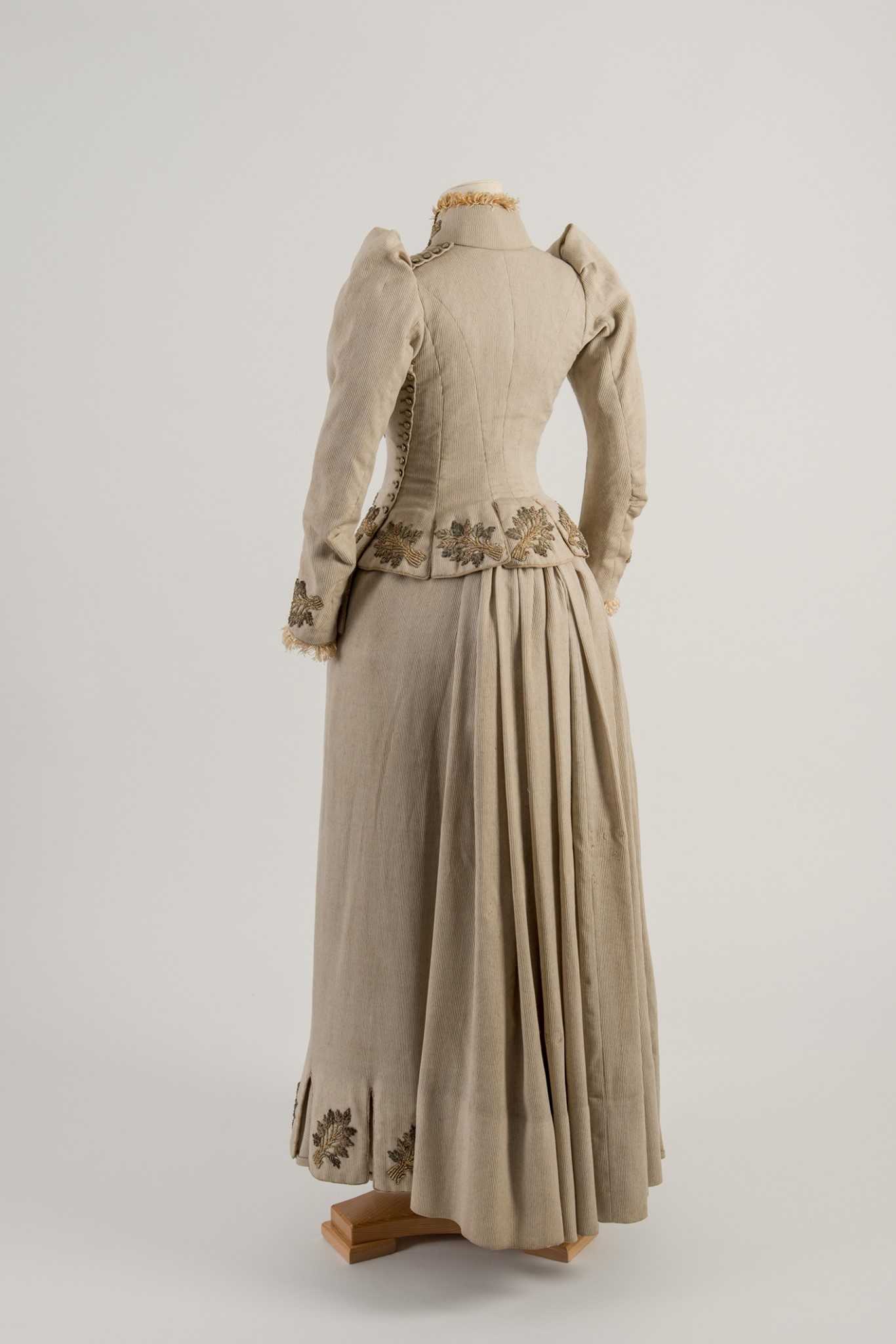
Walking dress, 1890-91, English, H J Griffin, Nottingham. Light grey corded wool with embroidered leaf motifs. Featured in Janet Arnold’s ‘Patterns of Fashion 2, Fashion Museum Bath
This particular example gives a nod to the idea of a train with a full gathered skirt section at the back of the dress. A slight pad at the back is all that remains of the recently fashionable bustle. The fullness of the back pleating, which is held in place under the skirt with ties, would have accommodated a full bustle should they become fashionable again.
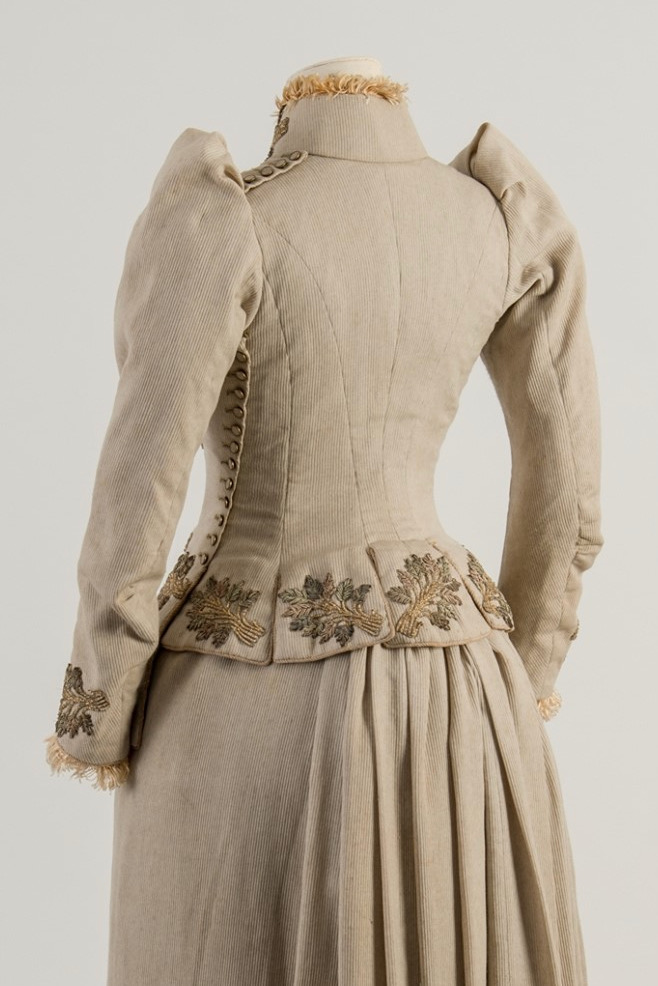
Walking dress, 1890-91, English, H J Griffin, Nottingham. Light grey corded wool with embroidered leaf motifs. Featured in Janet Arnold’s ‘Patterns of Fashion 2, Fashion Museum Bath
The embroidery design, with its motifs forming garlands that weave around the bodice and wrap round the hem, is of a type fashionable from the late 1870s through to the end of the 1880s. We’ve seen similar examples on this Mon. Vignon dinner dress, and this Alice Larrot reception gown, and, to a lesser extent, this cherry bedecked day dress.
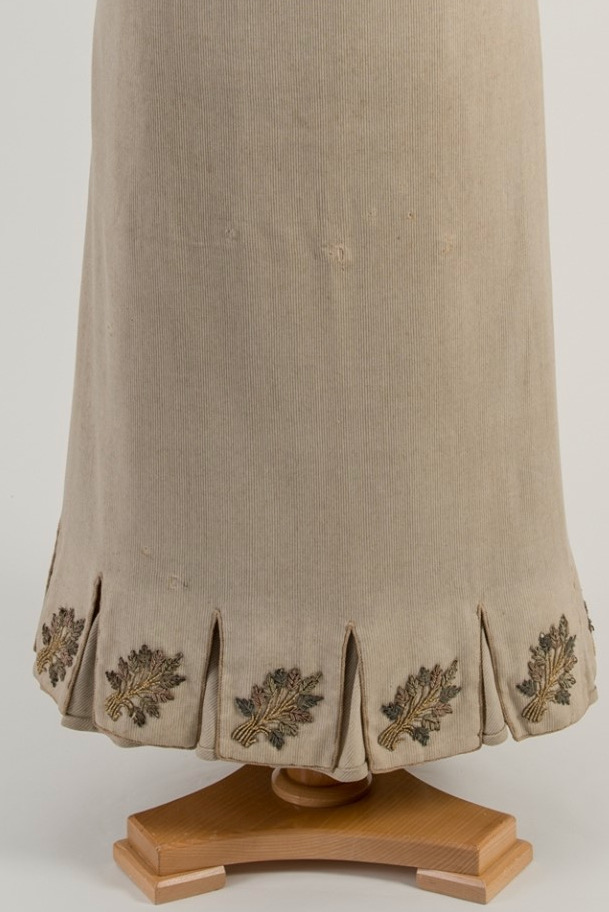
Walking dress, 1890-91, English, H J Griffin, Nottingham. Light grey corded wool with embroidered leaf motifs. Featured in Janet Arnold’s ‘Patterns of Fashion 2, Fashion Museum Bath
Because this dress is included in Patterns of Fashion 2, we know more details about its construction. It fastens at the center front with 19 hooks and eyes, and then the left front wraps over, hiding the hooks, and fastens again under the arm and at the left shoulder with buttons.
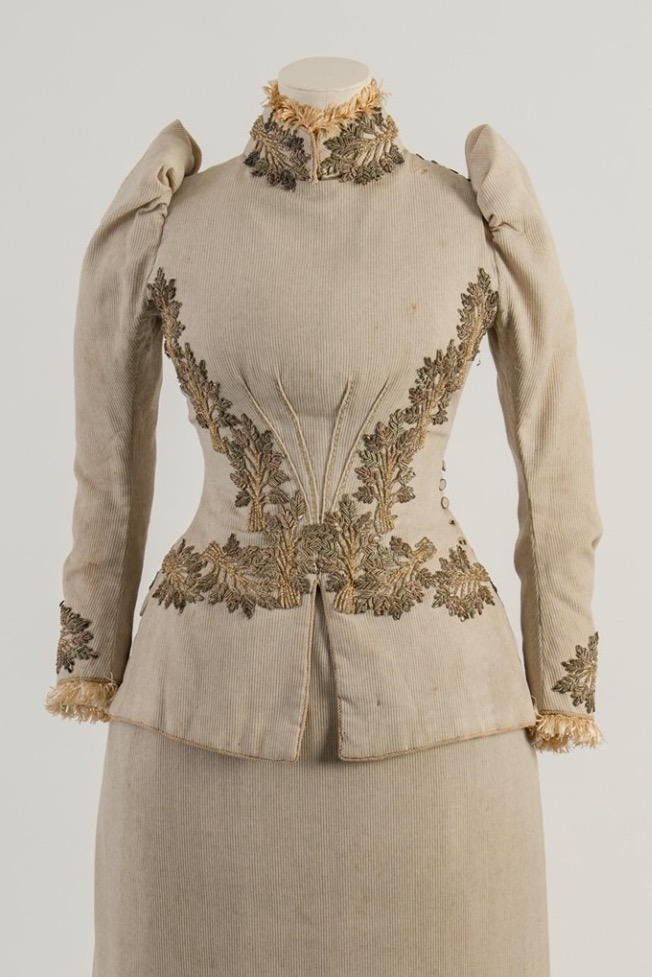
Walking dress, 1890-91, English, H J Griffin, Nottingham. Light grey corded wool with embroidered leaf motifs. Featured in Janet Arnold’s ‘Patterns of Fashion 2, Fashion Museum Bath
The bodice is heavily boned, to provide a smooth line. There’s a large pocket hidden in the fullness of the skirt folds on the left back side only. The sleeves are not gathered, but are fitted in to the armscye with pleated tucks, providing the distinctive pointed, sculptural shape we see.

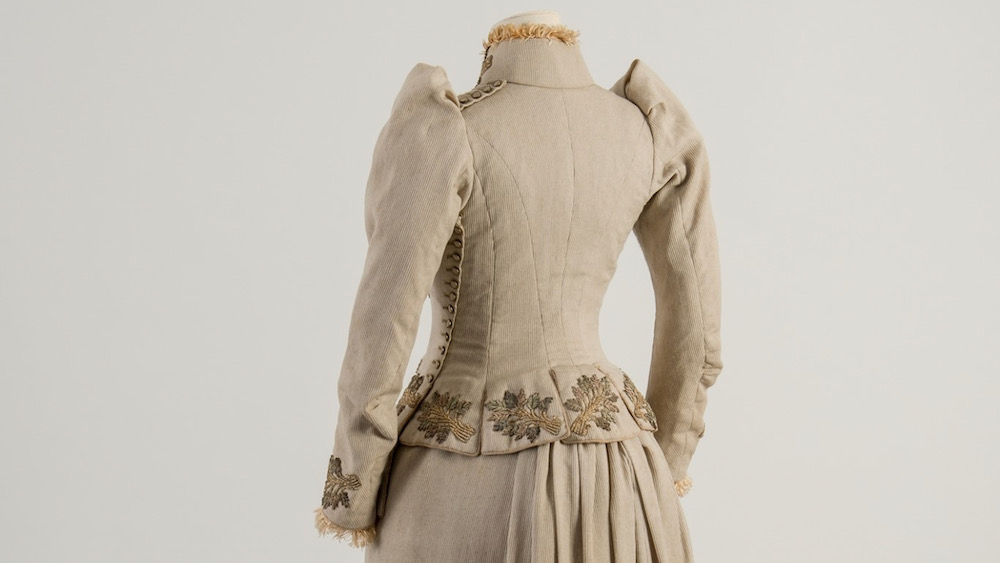
In love with the color scheme and the way the linen drapes. Somehow I think this dress would be more attractive with a lighter weight embroidery; it’s almost too embellished. I feel bad saying that since someone obviously devoted many hours of their life to it.
The bit of yellow fringe around the neck and sleeves is a bit twee for me. Those architectural shoulders… well, I have wide shoulders and presumably the lady wearing this size didn’t, so I will just accept that it looked good on the intended wearer and call it original and striking.
That bodice shaping is intriguing; they took a construction feature and made it a design element. The hem pleats are a work of art and provide more room for a good walking stride.
Ten for the dress’s lines and functionality with great style, and eight for the rather too heavy embroidery, resulting in a solid 9. Glad I got to see it, it gave me some good ideas for my walking dress, and I would hire this dressmaker in a hot expensive instant.
9
Much to like about this dress. The embroidery around the hem is lovely, with the little dags echoing the edge of the ‘jacket’ part, and I do like the military look of the high collar. The back view is a delight – the fitted top and the bustle under the top. I don’t feel quite as sure about the front view. The way the embroidery loops under the bust, leaving the great expanse of grey/fawn is a bit disconcerting. Like the plunging Minoan neckline you are not actually having.
8 out of 10.
I think it is beautiful but two things really strike me as impractical:
-Having fluffy fly type trim under the chin would be so ticklish, and,
– those tiny buttons!!! And you have to get them open to get in and out! It would be so fiddly. I feel claustrophobic.
Apart from these reminders that clothing for the wealthy can be time consuming, i think it lovely. I enjoy the tabbed skirt, the autumnal swirls of embroidery an the shape and scale of it.
8.
So many things I love about this dress, yet so many, eh. The pleats and pin tucks (I do love both technics), the pleated sleeve and the embroidery are lovely. The faux bustle back is nice, but I could wish the embroidery continued. The colors are safe, but maybe the embroidery has faded? I would like to see a more vivid green. The buttoned crossover bodice is so precious. I like the look but feel it would be annoying to feel the buttons under one’s arm. The vast expanse of empty bodice needs a magnificent brooch. Altogether, it’s lovely but not delicious. 8/10
there are elements of this dress that i like very much: colour scheme, embroidered ornaments, general silhouette. and there are elements about it that miss the mark, for me: the bodice ornamentation is deployed less than optimally, leaving an unflattering space between collar and side-front embroidery, and the lack of embroidery on the back gathered area’s hem. that latter really bothers my eye; i do not care for the transition between the embroidered tabbed hem and the tab-less, un-embroidered gathered skirt. it looks like an unfinished after-thought.
rating: 6/10
Och. I genuinely do like a lot of the 1890 period in general – the shelf bustle is gone but there’s a sweep; sleeves have charming kick-ups but aren’t enormous yet. The embroidery on this dress is charming, but the overall color is drab. I agree with other users that the fly fringe doesn’t quite work. I’d prefer to see the buttons somewhere on the front of the bodice (diagonal maybe? Call back to 1880s asymmetry? Adapt the embroidery to the shape). The unbroken, high-necked bodice front reminds me of a dress dummy.
7.5/10
I think you hit the nail on the head when you say that plain expanse of bodice looks like a dress dummy!
Dislike the break in the skirt embroidery for the train. Fly fringe just under your chin and something about the colour and shape strikes me as a bit plodden or dumpy.
But like the embroidery at the neck and little tabs at the bottom
5/10
I do like the fabric, embroidered tabs (and I cheer the practicality of the higher hem).
The main offense to my eye is the heavy horizontal of the embroidery across the waist. I would far prefer that the embroidery of the tabs on the back be continued across the front, in addition to continuing the front skirt hem treatment all the way across the back.
The neck fringe should be eliminated.
8 of 10
This dress looks totally claustrophobic to me. I’m not a fan of the colour or style either. I do like the pleating around the hem. My overall impression is that this dress would be restrictive and uncomfortable. 5/10
Meh. There is much that is lovely, the embroidery, the texture of the fabric and the tailoring. It looks like a really practical ensemble, with a colour that would hide dust. But, I really don’t like the high “puffs” on the sleeves, or the front of the bodice. It needs something more at the throat to balance the decoration below the bust. And, I really don’t like the abrupt change between the small pleats at the hem in the front to the very full back. I would wear this in a darker colour (charcoal, brown or navy), with brighter colours in the embroidery and other trim and a lace jabot with a good sized cameo brooch. But as it is, I can only give it 6/10
I have examinated this one from top to bottom, front to back and… it’s actually kind of bad.
I like four things about it: the color scheme, overall silouhette, the interesting closure and the back view.
After that, its just not so good. The fringe (if I’m seeing right, its ostrich feather fringe) is dumpy and impractical. The embroidery is placed ungracefully. And, well, I looked at it quite closely and I think it’s more likely just pre-made applique, so not so good. The tabs and the bodice split in the front of the bodice are not crisp enough, and if I’m being honest, the front tabs and the split should have been omited alltogether. Those four pintucks in the front are reminding me of myself, decades ago, when I was sewing wardorbe for my Barbies. I have learned how to do tucks properly, since then.
But the wors thing are the two lenghts of the bodice. I have not noticed at first, except something seemed off to me. And there it is – the back is way shorter than the front. You can see that in the backwiev photos, where the side of the front piece can be seen under the sleeve. And yes, from the front is the bodice as long as the sleeves, but from the back, its significantly shorter. Its not pretty, its not practical, maybe it was edgy then? Weird.
5/10
I absolutely love the back of this dress- so elegant with the embroidery and the way the jacket falls over the pleated skirt, and then you turn around and… I just don’t like the front of the dress near so much. There is too wide of an expanse of plain fabric over the bosom somehow. Maybe it needs more embellishment coming down from the collar? Or even if the bodice buttoned up the centre front instead of on the side, it would break up the fabric and add some interest. I too can only give it a 6/10.
I feel like I really ought to like this dress. I like all the individual elements, the colour, the fabric, the embroidery, the gathered and pleated back, the puffed sleeves, the side buttons. But somehow the effect of it all together just looks frumpy and unattractive to me. Something seems off about the lines of the dress to my eye. I’ll give it one point for each of the individual elements I like, so 6/10 for me.
This dress definitely gets credit for being walking length and made of a sturdy fabric in a practical color. The lack of embroidery on the “kinda-train” makes it look added on as an afterthought, as opposed to being a core part of the design. The front is a bit of a hot mess, however. The bodice front, with its side closing, brings a modern fencing jacket to mind. The broad expanse of fabric thus formed is not well served by the placement of the tucks or the trim. The feather trim on the collar and cuffs seems out of place in an otherwise practical garment. Other strange bits include the fact that the front of the bodice is several inches longer than the back (as was noted by a previous commenter), and that the underlayer in bottom front has its hem to the outside. I did like the tabs and think the dress would look better if that detail was consistent. The sleeve cap is a bit high, but probably not excessively so for the time period.
Rating: 7/10
I don’t it, but I do not love it either. The bottom front of the bodice seems a bit empty, as does the chest area, I believe the prior could have been fixed with more strategic applique placement, and the latter with a bit of lace and a brooch. I do not like the trim at the collar or cuffs at all, it does not fit the general style of the dress and seems a bit to “dress-up” fancy to me. I do like the skirt but I would have liked the tabs to continue around the hem and for the front to be a bit fuller as it seems a bit columnar… and not in a good way. I like the simple color scheme, it would be a good dress for walk through the woods in autumn.
6/10
From the back: I adore! From the front: I abhor!
Well maybe not quite that bad but I think you get the picture. The back looks lovely and trim and taylored and chic, despite the puffy sleeves. The side buttons are a neat little touch too.
I find the front weirdly bare where there is no trim, the darts look odd and the color scheme becomes boring instead of sophisticated. And I suddenly hate the sleeves instead of seeing them as a small flaw in an otherwise lovely outfit. The trim on the collar makes it look very tall and kind of chokey.
The front gets a 3 and the back gets an 8 so the final rating is 5? I guess?
Rating 5/10
My first response: amazing except for the sleeve cap.
Then I found the vast expanse of bust unpleasant. Perhaps the outfit was designed to showcase an necklace? It seems something is missing there.
Overall, a stunning but slightly off dress.
Rating: 9
6/10